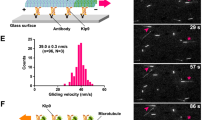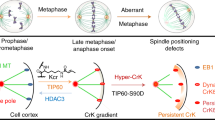Abstract
Chromosome segregation requires the formation of K-fibres, microtubule bundles that attach sister kinetochores to spindle poles. Most K-fibre microtubules originate around the chromosomes through a non-centrosomal RanGTP-dependent pathway and become oriented with the plus ends attached to the kinetochore and the minus ends focused at the spindle poles. The capture and stabilization of microtubule plus ends at the kinetochore has been extensively studied but very little is known on how their minus-end dynamics are controlled. Here we show that MCRS1 is a RanGTP-regulated factor essential for non-centrosomal microtubule assembly. MCRS1 localizes to the minus ends of chromosomal microtubules and K-fibres, where it protects them from depolymerization. Our data reveal the existence of a mechanism that stabilizes the minus ends of chromosomal microtubules and K-fibres, and is essential for the assembly of a functional bipolar spindle.
This is a preview of subscription content, access via your institution
Access options
Subscribe to this journal
Receive 12 print issues and online access
$209.00 per year
only $17.42 per issue
Buy this article
- Purchase on Springer Link
- Instant access to full article PDF
Prices may be subject to local taxes which are calculated during checkout






Similar content being viewed by others

References
Walczak, C. E. & Heald, R. Mechanisms of mitotic spindle assembly and function. Int. Rev. Cytol. 265, 111–158 (2008).
O’Connell, C. B. & Khodjakov, A. L. Cooperative mechanisms of mitotic spindle formation. J. Cell Sci. 120, 1717–1722 (2007).
Gruss, O. J. et al. Chromosome-induced microtubule assembly mediated by TPX2 is required for spindle formation in HeLa cells. Nat. Cell Biol. 4, 871–879 (2002).
Karsenti, E. & Vernos, I. The mitotic spindle: a self-made machine. Science 294, 543–547 (2001).
Kalab, P., Weis, K. & Heald, R. Visualization of a Ran-GTP gradient in interphase and mitotic Xenopus egg extracts. Science 295, 2452–2456 (2002).
Caudron, M., Bunt, G., Bastiaens, P. & Karsenti, E. Spatial coordination of spindle assembly by chromosome-mediated signaling gradients. Science 309, 1373–1376 (2005).
Kalab, P., Pralle, A., Isacoff, E. Y., Heald, R. & Weis, K. Analysis of a RanGTP-regulated gradient in mitotic somatic cells. Nature 440, 697–701 (2006).
Carazo-Salas, R. E. et al. Generation of GTP-bound Ran by RCC1 is required for chromatin-induced mitotic spindle formation. Nature 400, 178–181 (1999).
Carazo-Salas, R. E., Gruss, O. J., Mattaj, I. W. & Karsenti, E. Ran-GTP coordinates regulation of microtubule nucleation and dynamics during mitotic-spindle assembly. Nat. Cell Biol. 3, 228–234 (2001).
Wollman, R. et al. Efficient chromosome capture requires a bias in the ‘search-and-capture’ process during mitotic-spindle assembly. Curr. Biol. 15, 828–832 (2005).
McEwen, B. F., Heagle, A. B., Cassels, G. O., Buttle, K. F. & Rieder, C. L. Kinetochore fiber maturation in PtK1 cells and its implications for the mechanisms of chromosome congression and anaphase onset. J. Cell Biol. 137, 1567–1580 (1997).
Walczak, C. E., Cai, S. & Khodjakov, A. Mechanisms of chromosome behaviour during mitosis. Nat. Rev. Mol. Cell Biol. 11, 91–102 (2010).
Rizk, R. S. et al. MCAK and paclitaxel have differential effects on spindle microtubule organization and dynamics. Mol. Biol. Cell 20, 1639–1651 (2009).
Kline-Smith, S. L., Khodjakov, A., Hergert, P. & Walczak, C. E. Depletion of centromeric MCAK leads to chromosome congression and segregation defects due to improper kinetochore attachments. Mol. Biol. Cell 15, 1146–1159 (2004).
Maiato, H., DeLuca, J., Salmon, E. D. & Earnshaw, W. C. The dynamic kinetochore-microtubule interface. J. Cell Sci. 117, 5461–5477 (2004).
Wordeman, L., Wagenbach, M. & von Dassow, G. MCAK facilitates chromosome movement by promoting kinetochore microtubule turnover. J. Cell Biol. 179, 869–879 (2007).
Kops, G. J., Saurin, A. T. & Meraldi, P. Finding the middle ground: how kinetochores power chromosome congression. Cell Mol. Life Sci. 67, 2145–2161 (2010).
Mitchison, T. J. Polewards microtubule flux in the mitotic spindle: evidence from photoactivation of fluorescence. J. Cell Biol. 109, 637–652 (1989).
Waters, J. C., Mitchison, T. J., Rieder, C. L. & Salmon, E. D. The kinetochore microtubule minus-end disassembly associated with poleward flux produces a force that can do work. Mol. Biol. Cell 7, 1547–1558 (1996).
Rogers, G. C., Rogers, S. L. & Sharp, D. J. Spindle microtubules in flux. J. Cell Sci. 118, 1105–1116 (2005).
Ren, Y., Busch, R. K., Perlaky, L. & Busch, H. The 58−kDa microspherule protein (MSP58), a nucleolar protein, interacts with nucleolar protein p120. Eur. J. Biochem. 253, 734–742 (1998).
Shimono, K., Shimono, Y., Shimokata, K., Ishiguro, N. & Takahashi, M. Microspherule protein 1, Mi-2β, and RET finger protein associate in the nucleolus and up-regulate ribosomal gene transcription. J. Biol. Chem. 280, 39436–39447 (2005).
Hirohashi, Y. et al. p78/MCRS1 forms a complex with centrosomal protein Nde1 and is essential for cell viability. Oncogene 25, 4937–4946 (2006).
DeLuca, J. G., Moree, B., Hickey, J. M., Kilmartin, J. V. & Salmon, E. D. hNuf2 inhibition blocks stable kinetochore-microtubule attachment and induces mitotic cell death in HeLa cells. J. Cell Biol. 159, 549–555 (2002).
Tulu, U. S., Fagerstrom, C., Ferenz, N. P. & Wadsworth, P. Molecular requirements for kinetochore-associated microtubule formation in mammalian cells. Curr. Biol. 16, 536–541 (2006).
Gruss, O. J. & Vernos, I. The mechanism of spindle assembly: functions of Ran and its target TPX2. J. Cell Biol. 166, 949–955 (2004).
Klebig, C., Korinth, D. & Meraldi, P. Bub1 regulates chromosome segregation in a kinetochore-independent manner. J. Cell Biol. 185, 841–858 (2009).
DeLuca, J. G. et al. Kinetochore microtubule dynamics and attachment stability are regulated by Hec1. Cell 127, 969–982 (2006).
Gruss, O. J. et al. Ran induces spindle assembly by reversing the inhibitory effect of importin α on TPX2 activity. Cell 104, 83–93 (2001).
Wittmann, T., Wilm, M., Karsenti, E. & Vernos, I. TPX2, A novelXenopus MAP involved in spindle pole organization. J. Cell Biol. 149, 1405–1418 (2000).
Vasquez, R. J., Gard, D. L. & Cassimeris, L. XMAP from Xenopus eggs promotes rapid plus end assembly of microtubules and rapid microtubule polymer turnover. J. Cell Biol. 127, 985–993 (1994).
Gard, D. L. & Kirschner, M. W. A microtubule-associated protein from Xenopus eggs that specifically promotes assembly at the plus-end. J. Cell Biol. 105, 2203–2215 (1987).
Schatz, C. A. et al. Importin α-regulated nucleation of microtubules by TPX2. EMBO J. 22, 2060–2070 (2003).
Kinoshita, K., Arnal, I., Desai, A., Drechsel, D. N. & Hyman, A. A. Reconstitution of physiological microtubule dynamics using purified components. Science 294, 1340–1343 (2001).
Khodjakov, A., Cole, R. W., Oakley, B. R. & Rieder, C. L. Centrosome-independent mitotic spindle formation in vertebrates. Curr. Biol. 10, 59–67 (2000).
Mahoney, N. M., Goshima, G., Douglass, A. D. & Vale, R. D. Making microtubules and mitotic spindles in cells without functional centrosomes. Curr. Biol. 16, 564–569 (2006).
Kalab, P. & Heald, R. The RanGTP gradient—a GPS for the mitotic spindle. J. Cell Sci. 121, 1577–1586 (2008).
Desai, A., Verma, S., Mitchison, T. J. & Walczak, C. E. Kin I. kinesins are microtubule-destabilizing enzymes. Cell 96, 69–78 (1999).
Lan, W. et al. Aurora B phosphorylates centromeric MCAK and regulates its localization and microtubule depolymerization activity. Curr. Biol. 14, 273–286 (2004).
Ems-McClung, S. C. & Walczak, C. E. Kinesin-13s in mitosis: key players in the spatial and temporal organization of spindle microtubules. Semin. Cell Dev. Biol. 21, 276–282 (2010).
Hunter, A. W. et al. The kinesin-related protein MCAK is a microtubule depolymerase that forms an ATP-hydrolyzing complex at microtubule ends. Mol. Cell 11, 445–457 (2003).
Goodwin, S. S. & Vale, R. D. Patronin regulates the microtubule network by protecting microtubule minus ends. Cell 143, 263–274 (2010).
Brunet, S. et al. Characterization of the TPX2 domains involved in microtubule nucleation and spindle assembly in Xenopus egg extracts. Mol. Biol. Cell 15, 5318–5328 (2004).
Bayliss, R., Sardon, T., Vernos, I. & Conti, E. Structural basis of Aurora-A activation by TPX2 at the mitotic spindle. Mol. Cell 12, 851–862 (2003).
Maresca, T. J. et al. Spindle assembly in the absence of a RanGTP gradient requires localized CPC activity. Curr. Biol. 19, 1210–1215 (2009).
Sampath, S. C. et al. The chromosomal passenger complex is required for chromatin-induced microtubule stabilization and spindle assembly. Cell 118, 187–202 (2004).
Khodjakov, A., Copenagle, L., Gordon, M. B., Compton, D. A. & Kapoor, T. M. Minus-end capture of preformed kinetochore fibers contributes to spindle morphogenesis. J. Cell Biol. 160, 671–683 (2003).
Wittmann, T., Boleti, H., Antony, C., Karsenti, E. & Vernos, I. Localization of the kinesin-like protein Xklp2 to spindle poles requires a leucine zipper, a microtubule-associated protein, and dynein. J. Cell Biol. 143, 673–685 (1998).
McAinsh, A. D., Meraldi, P., Draviam, V. M., Toso, A. & Sorger, P. K. The human kinetochore proteins Nnf1R and Mcm21R are required for accurate chromosome segregation. EMBO J. 25, 4033–4049 (2006).
Amaro, A. C. et al. Molecular control of kinetochore-microtubule dynamics and chromosome oscillations. Nat. Cell Biol. 12, 319–329 (2010).
Sardon, T., Peset, I., Petrova, B. & Vernos, I. Dissecting the role of Aurora A during spindle assembly. EMBO J. 27, 2567–2579 (2008).
Peset, I. et al. Function and regulation of Maskin, a TACC family protein, in microtubule growth during mitosis. J. Cell Biol. 170, 1057–1066 (2005).
Acknowledgements
We thank S. Gross for statistical analysis of data; M. Mendoza, J. Solon, T. Surrey and the Vernos laboratory’s members for helpful discussions and critical comments on the manuscript; P. Meraldi for the gift of the H2B–eGFP/α-tubulin–mRFP and H2B–RFP/PA-GFP–tubulin HeLa cell lines and anti-Mad1 antibodies, A. Khodjakov for the gift of the GFP–centrin-1 HeLa cell line and S. Rybina and E. Karsenti for the gift of purified MCAK and anti-MCAK antibodies. M. Sanz, N. Mallol, V. Beltran-Sastre and L. Ávila provided technical assistance. We thank the Advanced Light Microscopy Unit of the CRG for microscopy support. This work was funded by grants from the Spanish MEC and MICINN BFU2006-04694, BFU2009-10202 and CSD2006-00023.
Author information
Authors and Affiliations
Contributions
I.V. and S.M. designed the experiments. S.M. carried out all the experiments and analysed the data. I.V. and S.M. wrote the manuscript.
Corresponding author
Ethics declarations
Competing interests
The authors declare no competing financial interests.
Supplementary information
Supplementary Information
Supplementary Information (PDF 889 kb)
Supplementary Movie 1
Supplementary Information (AVI 304 kb)
Supplementary Movie 2
Supplementary Information (AVI 328 kb)
Supplementary Movie 3
Supplementary Information (AVI 206 kb)
Supplementary Movie 4
Supplementary Information (AVI 188 kb)
Supplementary Movie 5
Supplementary Information (AVI 1585 kb)
Supplementary Movie 6
Supplementary Information (AVI 277 kb)
Supplementary Movie 7
Supplementary Information (AVI 778 kb)
Supplementary Movie 8
Supplementary Information (AVI 1270 kb)
Rights and permissions
About this article
Cite this article
Meunier, S., Vernos, I. K-fibre minus ends are stabilized by a RanGTP-dependent mechanism essential for functional spindle assembly. Nat Cell Biol 13, 1406–1414 (2011). https://doi.org/10.1038/ncb2372
Received:
Accepted:
Published:
Issue Date:
DOI: https://doi.org/10.1038/ncb2372
This article is cited by
-
Oncogenic potential of BEX4 is conferred by Polo-like kinase 1-mediated phosphorylation
Experimental & Molecular Medicine (2018)
-
Deficiency of RITA results in multiple mitotic defects by affecting microtubule dynamics
Oncogene (2017)
-
Mitotic spindle assembly in animal cells: a fine balancing act
Nature Reviews Molecular Cell Biology (2017)
-
MCRS1 associates with cytoplasmic dynein and mediates pericentrosomal material recruitment
Scientific Reports (2016)
-
An epigenetic regulator emerges as microtubule minus-end binding and stabilizing factor in mitosis
Nature Communications (2015)


